For Hildegard, health and healing sought balance in all aspects of life. She honoured interconnectivity – of spirit, mind, body; of humanity, the earth and the universe. This is the heart of Hildegard’s healing philosophy, though not unique to her. Buddha emphasised the middle way as the path of moderation and the path of wisdom. The Tao always reminds us to move towards finding the balance as with dark and light.
What would eventually set her apart, however, was how she chose to embrace the middle ground set forth in the Rule of St. Benedict. This enabled her to engage in her individual passion while serving the stringent institutionalism of the Church.
It was within this middle ground that she pressed her will and intellect into the interconnectivity of the physical and spiritual worlds, culminating in her foundational work in natural medicine.
From her early years Hildegard worked with garden plants and herbs for healing. This can be seen in the following poem when Jutta is dying. ( from Book 111 of Hildegard of Bingen: A Poetic Journey)
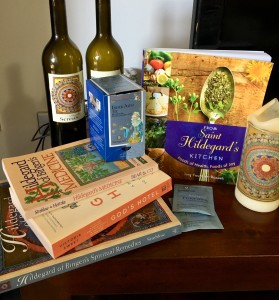
Some of the books of the 21st century I have that are inspired by Hildegard of Bingen
Last Swallows
Hildegard’s world stands bleak,
bare. The last swallows long gone.
In cold light
dew drops hang on a blade of grass.
Lingering dread
knots her stomach.
She enters the anchorage
sighs deeply,
lights Advent’s second candle.
Its smoky glow
reveals the pale beauty of Jutta’s face,
she lies stilled.
Hildegard puts down some bowls,
kisses her forehead.
Jutta, my mother,
your ascetics are too harsh.
Your imprisoned cell here
is mortification enough.
Let our spirits give praise
with rhythm of music,
with song of jubilation.
Our God, the Just One, is she who offers life
with all its bountiful gifts.
She nurtures Jutta,
urges with sips of fennel tea,
warmed broth, mulled honeyed wine.
Oil from the olives, freshly pressed,
she heats over the smouldering hearth,
gently massages Jutta’s hands and feet.
Her flesh wasted.
Jutta has her mind only
on heaven,
to be remembered as a saint.
Hildegard kneels beside her
holds her cold hands,
listens to her trailing breath.
She loves this broken woman.
Colleen Keating
from Hildegard of Bingen : A Poetic Journey

Later Hildegard came to understand everything is given us
for our wellbeing. She would write later about the interconnection of all things.
There is no creation that does not have a radiance,
be it greenness or seed, blossom or beauty,
it could not be creation without it. Hildegard of Bingen
In 1150, Hildegard left the Monastery at Disibodenberg and led her sisters to set up the new Abbey at Rupertsberg. There she embarked on deep and valuable work in lifestyle, nutrition, and well being for her sisters. Word spread around the of her healing ways.
When Hildegard left the Monastery at Disibodenberg and led her sisters to set up the new Abbey at Rupertsberg in 1150 she embarked on deep and valuable work in lifestyle, nutrition, and well being for her sisters. And word spread around the Rhineland of her healing ways.
Hippocrates, the father of modern medicine, declared “let food be thy medicine, and medicine be they food.” The concept of food as medicine is ancient. Hildegard was one of the first in Mediaeval Western civilisation that connected health and nutrition.
Food as medicine is the core for Hildegard of Bingen. Her notion that a kitchen is also a pharmacy reflects a common theme among ancient traditions of healing: food is the first medicine. Medicines at the time were all plant based or specific combinations of foods prescribed according to their unique healing qualities.
Hildegard’s original work, was eventually split into two treatises, Physica and Causae et Curae –
“Physica” represents the history of natural remedies, which Hildegard had intended for public use. and in Causae et Curae Hildegard describes healing and treatment methods using humoral techniques along with traditional creation teachings, combined with ancient mystic Cosmologies.
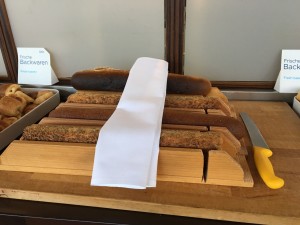 i
i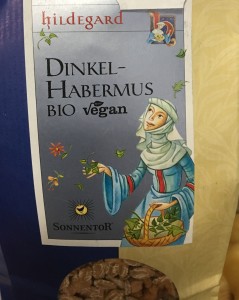
The wonderful selections of breads at breakfast, in our Bingen Hotel overlooking the Rhine. It felt very much as if hildegard is present.
Today especially in Germany, Hildegard’s healing treatments have found a resurgence in holistic health and wellness.
Within this renaissance Hildegard’s philosophies around health and nutrition provide concrete ways to achieve a healthy spirit, mind, and body, which ultimately lead to a healthy lifestyle. From this healthy lifestyle we harvest many benefits, not the least of which is avoiding illness and unnecessary suffering.
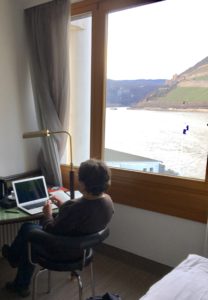
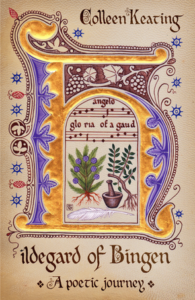



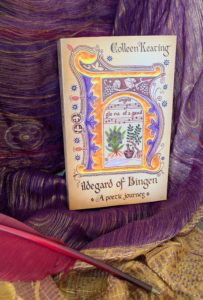
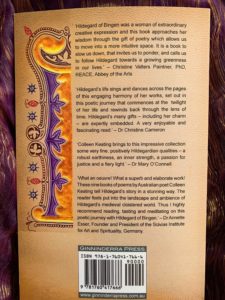


 i
i